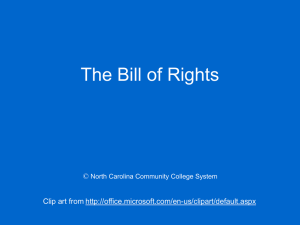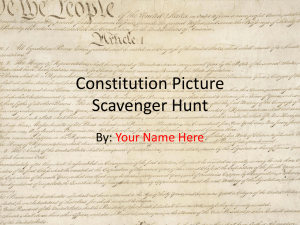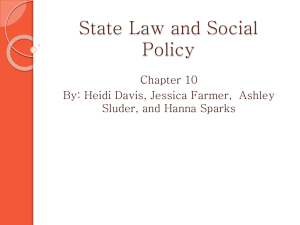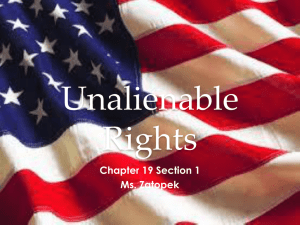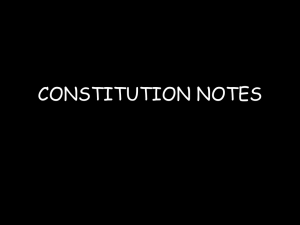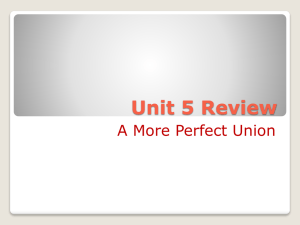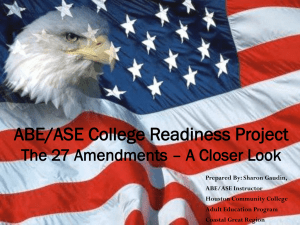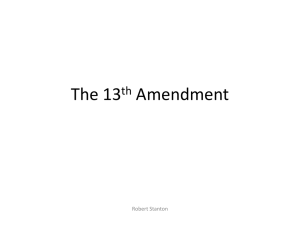Constitution Power Point
advertisement
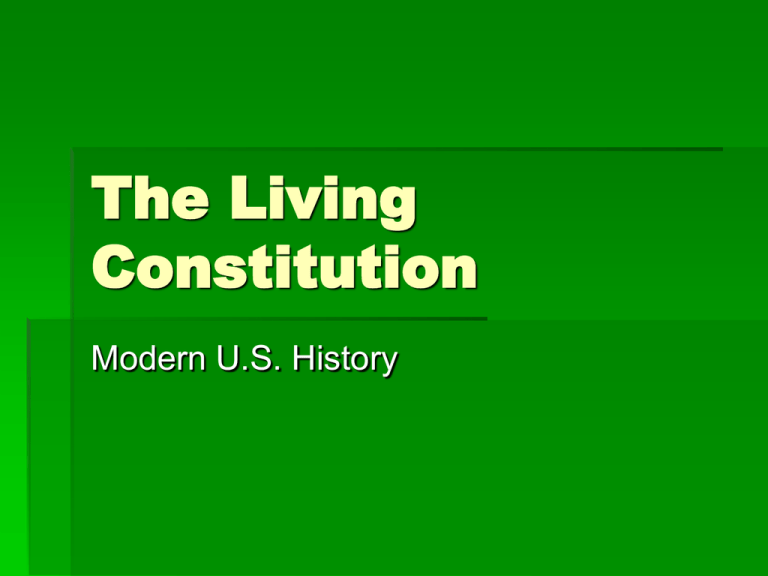
The Living Constitution Modern U.S. History The 7 “Principles” of the Constitution Popular Sovereignty Republicanism Federalism Separation of Powers Checks and Balances Limited Government Individual Rights Popular Sovereignty This concept means that the “people” rule in our country We are the source of the government’s power This has taken on new people throughout history (like who?) African American men (1865) Women (1920) 18 year olds (1971) Republicanism Our government works by people choosing our leaders – who then make the decisions for us Federalism Federalism is a system of “shared” powers between the national government and the state governments 1. Maintain Military 2. Declare War 3. Post Offices 4. Weights and Measures 5. Protect Copyrights 1. Establish local Governments 2. Schools 3. Regulate state Commerce 4. Marriage Regulations 5. Drivers Licenses Separation of Powers Power in our government is split, or separated among 3 branches Executive (the president and those who serve under him/her) Legislative (Congress) Judicial (The Federal Courts) Checks and Balances Each branch of government exercises control, or a check on the other branches. This ensures that one branch doesn’t become too powerful Limited Government and Individual Rights Limited Government: Constitution lists things that the government cannot do. It also explain how all citizens, weak or strong, must obey the law Individual Rights: People get certain individual privileges – protections from powerful government The Electoral College Voters don’t choose President directly Each state has “electors” that make up the Electoral College Winner take all – meaning that if a candidate wins a state – they get all of that state’s ‘electors’ (with some exceptions) Electoral College Map – 2008 Election Barack Obama – Blue John McCain – Red Roles of the President Commander-in-Chief Chief Executive Chief Diplomat Legislative Leader Head of Political Party Commander-in-Chief Chief Executive Chief Diplomat & Chief of State Legislative Leader Head of Political Party Judicial Review Judicial Review is one of the most important powers the Judicial Branch has The Supreme Court (and other federal courts) have the power to examine laws and government activity and decide whether it violates the Constitution America: Both Federal and State Governments 1. Maintain Military 2. Declare War Taxes 3. Post Offices Courts 4. Weights and Measures Laws 5. Protect Copyrights Roads 1. Establish local Governments 2. Schools 3. Regulate state Commerce 4. Marriage Regulations 5. Driver’s Licenses Amending the Constitution Constitution can be amended – or changed Has been amended 27 times in history Amendment must be passed by 2/3 of BOTH houses of Congress – or application by 2/3 of the states To be passed: Amendment must be ratified by ¾ of state legislatures or ¾ of state conventions The Bill of Rights The first 10 Amendments to the Constitution Guarantees basic freedoms and liberties for all U.S. citizens The 1st Amendment The 1st Amendment guarantees Freedom of Speech Freedom of Religion Freedom of the Press Freedom of Assembly Freedom to Petition the Government Amendments 2-4 The 2nd Amendment: Citizens have the right to keep and bear arms The 3rd Amendment: The government cannot quarter troops in your home The 4th Amendment: Citizens have protection against illegal searches and seizures (gov’t must obtain a warrant & have probable cause to conduct a search) The 5th Amendment People accused of crimes have the right to not “incriminate” themselves The “Right” to remain silent No person is ever forced to testify against themselves Amendments 6-8: Protects those accused of crimes 6th Amendment: Right to a Speedy and Public Trial (also the right to hear the charges, right to call witnesses in your favor, and right to an attorney) 7th Amendment: Trial by Jury in Civil cases 8th Amendment: Limits of Fines and Punishments (no ‘excessive’ bail, or ‘cruel and unusual’ punishment) 9th Amendment: Addresses the rights of people that aren’t specifically stated in the Constitution 10th Amendment: Says that anything the Constitution doesn’t mention is left up to the states Other Famous Amendments 13th: Slavery is outlawed (1865) 16th: Income tax is allowed (1913) 18th: Prohibition of alcohol (1919) 19th: Women’s Suffrage (right to vote) (1920) 21st: Prohibition repealed (1933) 22nd: Limits President to 2 terms (1951) 25th: Presidential Disability/Succession (1967) 26th: 18 year olds can vote (1971) 27th: Congressional pay raises (1992) The Line of Succession after the President (who are they today???) 1. Vice-President 2. Speaker of the House 3. President Pro-Tempore of the Senate 4. Secretary of State 5. Secretary of Treasury Executive Departments (The President’s Cabinet) Leaders of all the Executive Departments serve in the President’s Cabinet – or closest group of advisors The President’s Cabinet The Secretary of… (they all serve as Presidential advisors and heads of their gov’t department) Agriculture Commerce Defense Education Energy Health & Human Services Homeland Security Housing and Urban Development Interior Justice (Attorney General) Labor State Transportation Treasury Veteran’s Affairs Key Members of our Government – those we need to know President Vice President Speaker of the House of Representatives President Pro-Tempore of the Senate Secretary of State 2 U.S. Senators from Wisconsin U.S. Representative whose district includes Waterford Governor of Wisconsin The President of the United States Barack Obama The Vice President of the United States Joe Biden The Speaker of the House of Representatives John Boehner President Pro-Tempore of the Senate Daniel Inouye The Secretary of State Hillary Clinton Chief Justice of the Supreme Court John Roberts Wisconsin’s 2 U.S. Senators Herb Kohl Ron Johnson U.S. Representative whose district includes Waterford Paul Ryan Wisconsin’s 1st District The Governor of Wisconsin Scott Walker Lt. Governor of Wisconsin Rebecca Kleefisch State Representative and State Senator for the Village and Town of Waterford State Rep. David Craig District 83 State Sen. Mary Lazich District 28 State Representative and State Senator for the Village Rochester, Town of Norway, and Town of Dover State Rep. Robin Vos District 63 State Sen. John Lehman District 21 *Those living in the Town of Norway will become part of a new Assembly district – the 62nd – following the fall 2012 election

